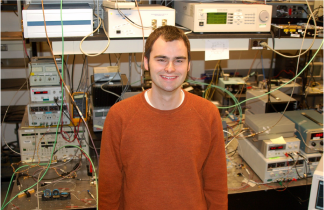(Robert Downey Jr. plays Tony Stark, defense contractor, billionaire playboy, scientific genius, and alter ego Iron Man. Image from www.comicbookmovie.com, still from Iron Man 2)
On Tuesday, May 3, I sat in on part of the Market Focus talks at the CLEO expo on defense. The Market Focus sessions cover various business and commercial applications of optics research. Last year was the first time I attended a Market Focus session, and I knew I had to go back. It is a little expo in itself that requires no walking- you to sit down and find out trends and problems that need solving in particular commercial areas. Great fodder for new research ideas!
Although the sessions are broken up into specific talks, what makes these sessions unique is that they turn into a round-table discussion at the end (and even during) the session. They have a more intimate and informal feel than the technical talks and have been organized with a specific agenda of bringing the attendee to a common understanding of the particular market being addressed.
For example, in the defense session, moderator John Koroshetz from Northrop Gruman Laser Systems laid out the logical order of talks to help us get our foot in the door of defense contracting: 1) Science and Technology Development, 2) Product Development, 3) Manufacturing, and 4) The Soldier's perspective. The aim was to help a novice understand the cycle of product development, funding, testing, manufacturing, and end-use, which often cycles back to development for upgrading and enhancing the product into its next-generation phase.
The first speaker, Craig Hoffman, from the Naval Research Laboratory, described science and technology development of infrared imaging systems. He broke up NRLs work in this area by spectral region:
-Visible: 0.4-0.7 microns (high photon energy makes devices tolerant to noise, but scattering makes it bad for imaging through dust or fog)
-Near IR: 0.7-3.0 microns (better for imaging through climate, but resolution gets worse because the wavelength is getting longer; becoming less tolerant to noise)
-Mid-IR: 3.0-5.0 microns (getting very good at seeing through climate, but getting even worse with resolution and noise tolerance; detectors may need to be cryogenically cooled to circumvent thermal noise)
-Longwave: 5.0-14.0 microns (least prone to scattering, worst for resolution and noise)
NRL is looking to piggy back imaging systems in these regions for applications in target acquisition, surveillance, and reconnaissance. The shorter wavelength systems use reflected light to gain information about detail of a target whereas the longer wavelength systems make use of emissive properties of a target to gain bulk properties like thermal imaging.
For example, new thermal imaging systems use mid-infrared light detection to gain detailed information about a target, but also use longwave detection in order to gain a wider field of view. You need both since by themselves the former sacrifices field for resolution and the latter sacrifices resolution for field.
Hoffman went on to describe military imaging problems that need better answers 1) Detailed target identification. You don't want to just know if a target is a tractor or a tank, but exactly whose tank it is (friend or foe?) and with enough time to either make evasive maneuvers or decide how to engage. 2) Fast data acquisition for reconnaissance. For this application, you want to collect data from an aircraft that is flying high and fast. You don't have the burden of real-time analysis like target acquisition (you can spend weeks later to analyze data), but you do need to collect enough information, with enough quality during the short acquisition time. 3) Surveilling a small area for weeks on end to look at changes in patterns like traffic flow, building construction, etc.
Hoffman spoke briefly about things like SWaP- size, weight, and power. This acronym represents all the things that should be as small as possible for a viable military product. Pete Vallianos from N2 Imaging systems followed up Hoffman's talk with more of the parameters, tests, and requirements related to SWaP. Vallianos underscored the importance of practicality and robust requirements when it comes to making products for the military. He repeatedly reminded the attendees that the military is not interested in your research per se (definitely not technology for its own sake), but rather interested in how technology might solve problems. While being developed, it needs to go through a variety of rigorous tests- one of the stress tests from the Marines is dropping your product from a height of six feet onto a piece of plywood . If it doesn't survive, it's back to the drawing board.
Vallianos described some specific product development interests of the military in imaging:
-microbolometers
-small eye safe lasers
-CMOS, low level light detection
-lightweight visible optics
-high transmission in optics across the visible spectrum through the longwave IR
-moldable aspheric lenses
-robust broadband optical coatings
-OLEDs
-LCDs
-Lightweight optical "network" on a soldiers back
-Any decrease in power for powered optics to get grid of as many of the batteries as possible a soldier needs to carry in his or her pack.
Though the speakers did not describe any iron suits with flying capability, or magic cold-fusion-like power supplies, I think Tony Stark still would have been proud of this session.

Small bits of content which are explained in details, helps me understand the topic, thank you!
ReplyDeletecommercial iron doors